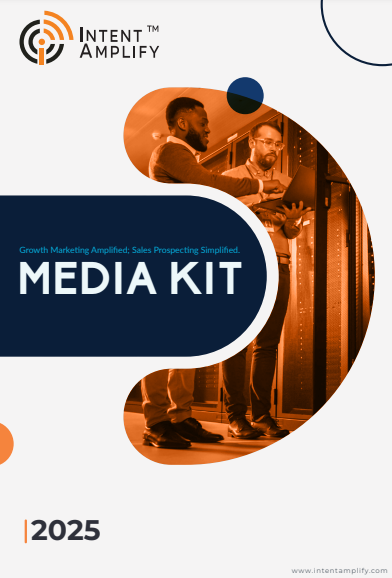ABI unifies account insights and intent signals, helping sales and marketing align seamlessly on high-value targets.

What Is Account-Based Intelligence and How Can You Use It in ABM?
- Last updated on: October 7, 2025
One of the challenges that marketing and sales teams face in a very competitive B2B environment is the question of how to deliver the right message to the right accounts at the right time. They might employ standard demand generation techniques such as launching wide campaigns, using generic outreach, and implementing mass lead scoring, but these methods are usually ineffective when they want to target high-value enterprise prospects.
Account-Based Intelligence (ABI) comes to the rescue. Through the use of precise, targeted, and actionable insights about accounts, ABI enables firms to move away from off-the-cuff supposition and the conventional types of outreach. Hence, marketing and sales staff can observe the behaviors of accounts, look into the perfect time to buy, and without any wasted efforts be in touch with the decision-makers, who are the first to be conversed with.
What is Account-Based Intelligence?
Account-Based Intelligence (ABI) is all about collecting, examining, and applying comprehensive and detailed data about potential customers to have more intelligent and effective ABM tactics. Unlike traditional account-based marketing that depends on static firmographic data or basic lead scoring, modern ABM leverages dynamic, real-time intelligence. ABI introduces current insights, predictive analytics, and enriched account data for sales and marketing decisions.
On the whole, ABI is the method for solving the biggest problems: Which accounts would be best to target are the ones that will most likely get involved? What do they do? How and when should we get in touch with them? It looks into data from different sources of data, like technographic and firmographic details, social media, website activities, and intent data and then links the account with the behavior and potential value.
Why Account-Based Intelligence Matters in ABM
Just touching a list of accounts is no longer effective in the data-rich era, where data is overabundant. Marketing and sales teams need to know who the target accounts are and what factors influence their decisions. This is how Account-Based Intelligence (ABI) wins the game for ABM.
ABI allows organizations to keep their focus on highly profitable accounts, to find the right audience with personalized messages, and to lower the amount of resources used on accounts that are of little interest. According to a study, 76% of marketers report more return with ABM than other strategies, and the companies that use ABM get 60% more successful results.
Besides engagement, ABI can deliver a wide range of business impacts that are measurable, such as faster pipeline velocity, higher conversion rates, and a great partnership between the marketing and sales teams.
Core Components of Account-Based Intelligence
It is by familiarizing oneself with the components at the base of Account-based Intelligence (ABI) that the full power of the system is realized. Through the process of a single-unit concept, it develops an all-encompassing account view, which enables not only marketing but also sales teams to select the most efficient routes for themselves.
1. Account Profiling and Segmentation
In order to identify the highly potential accounts, ABI carries out account profiling. The information includes not only the usual firmographics of the company size and the line of business, but also the organization structure, the dynamics of the buyer team, the revenue potential, and the historical engagement patterns.
Segmentation acts as a bridge between the sales and marketing departments for the better organization of accounts into groups. This implies grouping the clients by the kind of business and then choosing the segments to follow and those to ignore.
2. Predictive Intent Data
The predictive intent data signify which accounts are actively doing research on the solutions to their problems or are showing signs of buying. ABI uses AI and machine learning to collect and scrutinize digital behavior, content engagement, and search trends; this enables marketers to choose the next best step with respect to the accounts that have the highest chance of conversion.
3. Technographic, Firmographic, and Behavioral Insights
An effective ABI strategy needs to gather data from various perspectives:
- Technographics: What technology and applications are the company currently using?
- Firmographics: Number of employees, office location, annual turnover, and industry.
- Behavior: What content was consumed, website activity, and social signal.
These pieces of information, when combined, make the account complete.
4. AI-Driven Recommendations for Engagement
The AI-based suggestions by the ABI systems come accompanied by AI-generated ideas for communication, including the optimal social avenues, message, and scheduling for contact. This not only targets the repertoires but also renders precise tailoring achievable, which leads to the maximum amount of interactions and conversions being reached.
The ABI system, with these features working in unison, is the winning formula for businesses having to deal with other businesses in that it allows them to deploy their ABM campaigns in the most personalized, timely and data-driven manner, which then becomes the driver of the likeable growth.
How to Use Account-Based Intelligence in Your ABM Strategy?
Implementing Account-Based Intelligence (ABI) effectively requires a structured, data-driven approach. Research indicates that 36% of companies experience audience misalignment, where marketing focuses on broader audiences or different geographies and verticals, leading to ineffective targeting. Here’s how B2B organizations can integrate ABI into their ABM strategy to drive measurable results:
1. Identify High-Value Accounts
First, define accounts from where the most revenue can be generated, those that have the most strategic value, or which are most likely to adopt your product or solution. ABI supports such decisions by suggesting accounts for targeting through the use of predictive analytics, the analysis of historical engagement, and firmographic and technographic data.
2. Collect and Analyze Multi-Source Data
Access the knowledge of various sources: website activity, CRM systems, social engagement, technographic data, and third-party intent signals. ABI platforms bring together this data to compose an account view that is 360-degree, indicating the actions, needs, and purchasing intention of the account.
3. Build Personalized Campaigns
Insights can be used to dress up the messaging, content, and outreach strategies to fit the account. Personalization may include customized emails and content for targeted offers, events and multichannel campaigns specifically for the account. ABI makes certain that your communication with the most important people is at the right time, and they understand it.
4. Measure, Optimize, and Iterate
Measure campaign effectiveness through account engagement, pipeline progression, and conversion rates. ABI provides the opportunity for the team to see which accounts are responsive to them; thus, they can perfect their message and get the targeted audience they want to most effectively, to maximize the return on investment. Regular performance, ensuring that campaigns are continuously meeting the evolving needs of the account.
For instance, a SaaS firm focusing on global enterprise accounts can exploit ABI to reveal purchasing signals that were not visible before, prepare content that suits the needs of various stakeholders, and quicken the process of deal closure – thus turning intelligence into practical growth.
Common Challenges and How to Overcome Them
Though Account-Based Intelligence (ABI) brings a great deal of benefits, successfully handling it presents somewhat of a problem. The key to proving ABI’s ability to have a positive effect on ABM is to understand these barriers.
1. Data Integration Issues
Multiple sources – CRM systems, marketing platforms, intent data providers, etc are the basis of the insights in ABI. Without the perfect integration, the teams may end up with fragmentized or incomplete views of the accounts.
Solution: Get a reliable ABI platform that gathers data and has a strong connection with the tools that you already use, making the account view updated and real-time.
2. Ensuring Data Accuracy and Relevance
When data is old or inaccurate, the decision-making process might go wrong, and the result is the loss of time and the ability of the organization to grow.
Solution: Carry out data validation, enrichment, and cleaning processes continuously. Utilize AI-based tools that keep high-value accounts updated and prioritized automatically.
3. Organizational Alignment Between Marketing and Sales
ABI gives the highest return when marketing and sales are a tightly-knit team. Disalignment may then lead to inconsistencies or even double work.
Solution: Through joint account planning, shared KPIs as well and regular communication, both teams will always be on the same page with target accounts and engagement strategies.
After going through these problems, B2B companies are then free to make use of ABI to the fullest extent to turn account-level insights into actual revenue growth and treat ABM campaigns more efficiently.
FAQs
1. What is Account-Based Intelligence (ABI)?
ABI refers to the process of gathering, scrutinizing and utilizing in-depth customer data to fuel smarter, more tailored ABM strategies.
2. How does ABI differ from traditional ABM?
Although ABM is the method of engaging and targeting accounts, ABI makes use of predictive analytics, intent signals, and enriched data to make the right choices and to concentrate on a particular set of accounts, creating the most significant returns.
3. Which companies benefit most from ABI?
While tech, SaaS, fintech, and cybersecurity firms see the highest ROI, any B2B company using account-level engagement can benefit significantly.
4. What kinds of data are used in ABI?
ABI combines firmographic, technographic, behavioral, and predictive intent data, revealing every hidden insight within each account.
5. How can ABI enhance sales and marketing alignment?
Florence Harrison is a B2B content strategist at Intent Amplify®, with over 5 years of... Read more
Florence Harrison is a B2B content strategist at Intent Amplify®, with over 5 years of experience converting deep industry insights into value-backed stories that drive intent-led lead generation. Her content combines audience intelligence, intent-driven strategy, and intelligent automation to drive pipeline expansion and speed engagement along the buyer journey. With her high-impact storytelling and subtle editorial approach, Florence creates content structures that build out positioning, drive up visibility, and drive decision-makers in competitive B2B markets. Read less




